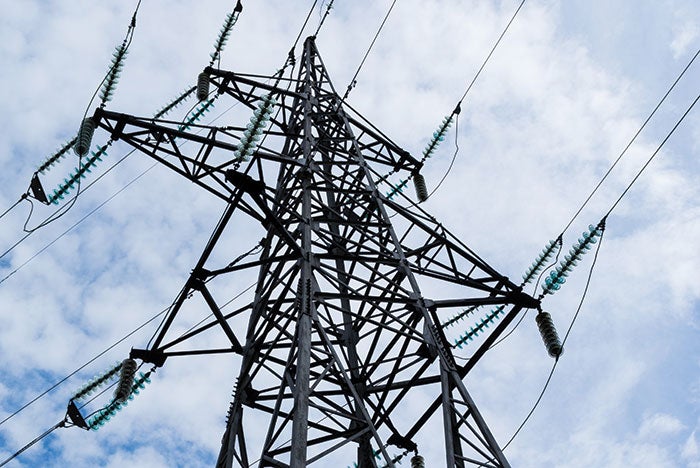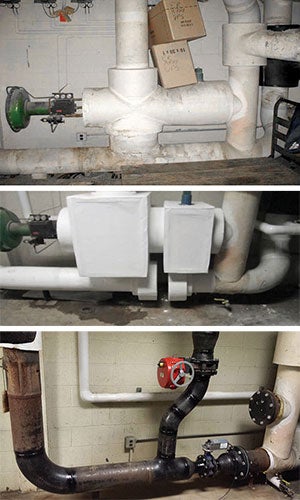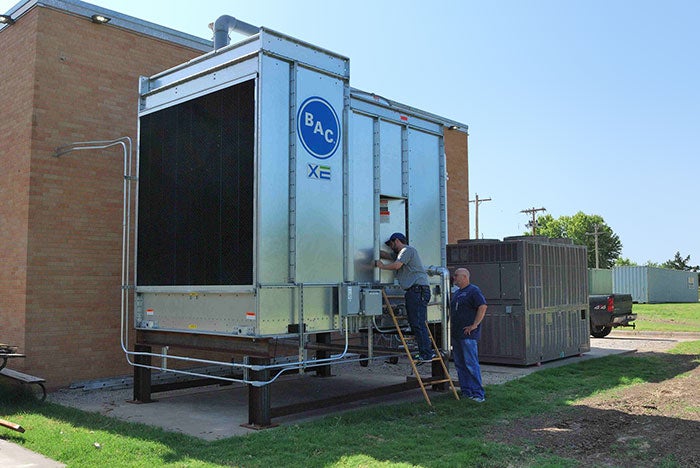Hospitals fine tune systems to achieve energy efficiency

During a time of uncertainty over U.S. health care, medical facilities need to streamline operations as much as possible so that more dollars are available for patient care. By reducing energy consumption, hospitals and health systems can achieve significant cost savings quickly without much up-front investment, say facility directors who’ve had success in this realm. What’s needed, though, is a comprehensive assessment of current energy-using systems and a well-thought-out action plan.
Among commercial buildings, hospitals remain the second-largest users of energy, after food-service facilities, says Clark A. Reed, the national program manager for Energy Star Commercial Buildings, a division of the Environmental Protection Agency (EPA). As facility managers know, hospital heating, ventilation and air-conditioning (HVAC) systems are the biggest energy guzzlers, often because they’ve been added to in a piecemeal fashion over many years.
That’s why Norman Ziemer, CHFM, director of facility management for Indiana (Pa.) Regional Medical Center (IRMC), decided to map out the hospital’s entire HVAC system in a process-and-instrumentation diagram soon after joining the medical center in 2009.
“We just mapped the entire process on one sheet of paper so it was in front of us,” Ziemer says. “This way, we had all of the details we needed to figure out what was going on in the system — why the water and the air were flowing the way they were.”
As a result, Ziemer and his team identified some 45 problems related to plumbing and hydraulics. The hospital adopted a strategic approach to address these issues, prioritizing the facility’s largest pipes.
“Because the biggest pipes would have the biggest flow problems, we started at the central plant,” Ziemer notes.
In partnership with an energy consulting firm and a mechanical contractor, IRMC took apart, reconfigured and welded many pipes, primarily to eliminate recirculation, working from the largest to progressively smaller pipes. The team discovered that by fixing major problems first, it eliminated many minor ones. A winner of the 2015 American Society for Healthcare Engineering (ASHE) Energy to Care Award, the hospital reduced its electricity consumption by 14 percent and its natural gas consumption by 21 percent, resulting in annual savings of $225,000 as well as a 28 percent decline in its energy use intensity (EUI), from 351 to 254 kBtu’s per square foot per year.

Indiana Regional Medical Center used a multistep process to redesign its chilled water system for better efficiency.
It took IRMC roughly 15 months to complete the energy-reduction project, including equipment ordering, according to Ziemer.
Hospitals and health systems with sophisticated building automation systems in place can achieve energy-efficiency gains considerably faster, points out Mark Dykes, energy projects manager for Gainesville, Fla.-based UF Health, which has saved millions of dollars since bringing its first fully automated building online eight years ago. “People will say that it’s too expensive, but it’s not,” he contends. “You can purchase the starting hardware and software for $35,000 to $45,000.”
UF Health, which has nearly 1,000 beds and approximately 3.5 million square feet of interior space, collects more than 200,000 points of data. “It’s mind-boggling to look at those points. We track every one of them every 15 minutes,” Dykes says, emphasizing that the automation system allows for continuous optimization. Rather than being overwhelming, the data help UF Health to be creative and predict failures, he maintains.
“We can go back nine years and use the data for fault detection,” Dykes explains, noting that UF Health, also an Energy to Care Award recipient, recently leveraged such historical data to save $250,000 in energy costs in the construction of a new outpatient surgery center.
Previously, when UF Health was moving into a new 500,000-square-foot facility, simple programming in the automation system saved the hospital $600,000 in energy costs in the first nine months, Dykes adds.
Stepwise approach
“If you don’t benchmark, you can’t measure what you’re doing,” energy champions are fond of saying. According to Reed, 85 percent of hospitals use the EPA’s Energy Star Portfolio Manager to benchmark, or measure and compare, their energy performance, many through ASHE’s Energy to Care program — a user-friendly tool for health facilities that integrates with Portfolio Manager.
After pinpointing areas of inefficiency through an energy audit, hospitals and health systems should pursue the proverbial “low-hanging fruit,” advises Steve Adams, director of plant operations, environmental services and laundry for 25-bed Russell (Kan.) Regional Hospital. Many of these energy-saving solutions are easy and inexpensive to implement and include such measures as installing occupancy sensors when light switches need to be replaced, repairing or replacing faulty steam traps, and turning off or turning down heating and cooling when and where it isn’t needed.
Health facilities can save significant energy by reducing their plug loads, for instance, by putting computers and copiers into sleep mode when not in use, adds Kara Brooks, LEED AP BD+C, ASHE’s sustainability program manager.
ASHE’s Sustainability Roadmap emphasizes the importance of preventive maintenance to maximize HVAC efficiency, noting that cooling towers should be cleaned to optimize condenser performance and air-handling unit filters should be replaced regularly.
“The Sustainability Roadmap describes many different measures that facilities can implement to achieve energy savings,” Brooks points out.
Russell Regional, which now has an Energy Star rating of 100, meaning that it is more energy efficient than all other hospitals of its size, hired an energy services company (ESCO) when the hospital became more serious about energy conservation. The ESCO determined that several significant upgrades needed to be made for optimal energy conservation. The lowest-cost projects with the quickest returns on investment included replacing T12 and older T8
fluorescent lighting with energy-efficient T8 lamps (a 4.5-year payback), installing variable-speed pumping (a 3.8-year payback), and replacing condensing units (a 5.0-year payback).
The most expensive projects, with the longest paybacks, were the chiller replacements (a 15.2-year payback on a more than $300,000 investment) and the boiler replacements (a 14.3-year payback on a nearly $475,000 investment).
Russell Regional previously had three old air-cooled chillers. “At all times, one of them was broken down, so they had all gone well beyond their useful lives,” remembers Adams, who spearheaded the already begun energy conservation initiative after joining the hospital. “In fact, I think one of them may have been more than 30 years old.”
Air-cooled chillers typically don’t function well when it’s cold outside, Adams notes. For better energy efficiency and temperature control, the hospital now uses a water-cooled chiller paired with a cooling tower during the coldest winter months.
“Instead of running the air-conditioning part of the chiller, we bypass into a heat exchanger and run the water outside over the cooling tower,” he explains. “The heat evaporates out of the water, and we’re able to cool the water just by using the cool outdoor air temperature.”
Russell Regional also purchased a new air-cooled chiller, which is operated during certain temperature parameters. “We stage it so we go from free cooling to the air-cooled chiller, then up to the water-cooled chiller when it gets super-hot outside,” Adams elaborates. In other words, each machine “stages in” when it is most efficient.
The new chiller configuration saves the critical access hospital roughly $20,000 a year, according to Adams.
Russell Regional also replaced steam boilers that were at the end of their useful lives with new condensing hot-water boilers, slashing energy costs by more than $33,000 a year. “The big problem with steam boilers is that it’s really hard to keep steam in a suspended state,” Adams observes. “When steam condenses into water, a steam boiler has to make more steam, whereas hot water can maintain its heat a lot longer.”
For larger hospitals and health systems, key energy-efficiency measures that should be considered range from operating room airflow setbacks to the replacement of fluorescent lighting with LED lighting. In new construction, buildings can be oriented to avoid large expanses of eastern and western exposures, tinted window glass can be used to reduce solar gain, and atria can provide an abundance of natural light, among countless possible design strategies.
With the goal of reducing its systemwide EUI by 20 percent from 2012 to the end of 2017, Charlotte, N.C.-based Carolinas HealthCare System has taken a four-pronged approach to conserving energy at its more than 15 hospitals and numerous medical office buildings in North Carolina, says Larry Bost, SASHE, CHFM, assistant vice president for facilities management and energy at the Energy to Care Award-winning health system.

Russell Regional Hospital hired an energy services company (ESCO) to help improve energy conservation. The improvements have earned Russell Regional an Energy Star rating of 100, meaning that it is more energy efficient than all other hospitals of its size.
First and foremost, Carolinas HealthCare pursues retrocommissioning, as defined by the ASHE Health Facility Commissioning Handbook and Guidelines. “Through a comprehensive room ventilation review and schedule, our building automation system is programmed so each hospital room based upon its use matches the code requirements for temperature, humidity, air changes and pressurization,” Bost explains.
“Retrocommissioning is the fastest to implement, the simplest to implement and the most cost-effective to implement, and it yields results in the shortest period of time,” Bost says. “If I had a limited budget and needed to take action in my organization to drive down energy use, retrocommissioning would be the first thing I would consider doing.”
The second most important component of Carolinas’ energy-reduction strategy is the use of OR setbacks — reducing the number of air changes from around 20 to six per hour without impacting temperature or humidity when an operating room is unoccupied and not scheduled to be in use. “But the moment someone comes into the room, [the OR setback program] goes into a countdown mode,” Bost says. If there is initial activity during the first two minutes, the sequences change and the ventilation schedule returns to normal OR surgery mode. It should be noted that when OR setback strategies are used, the required pressure relationships need to be maintained at all times.
The third and fourth prongs of Carolinas’ energy conservation strategy include replacing analog controls with digital controls and optimizing the chilled water plants for the health system.
“Our first efforts are focused on making our existing systems operate more efficiently before making large capital investments in new equipment,” Bost says.
Forward-looking systems
With lower natural gas prices and a U.S. administration that does not champion renewable energy, fewer hospitals these days are talking about alternative energy sources, although the Department of Veterans Affairs (VA) is reported to have spent more than $400 million on solar panel projects between 2010 and 2015. At the same time, the cost of solar energy technology has plunged, and many traditional utility companies are harnessing or looking to harness the sun’s rays.
“Renewables remain very important to energy conservation,’’ emphasizes Jonathan Flannery, CHFM, FASHE, FACHE, ASHE’s senior associate director of advocacy, who notes that investment in solar, wind, geothermal and other alternative energy systems varies widely by state, depending on the area’s climate, local business interests and the prevailing political leanings.
Two environmental sustainability leaders — Oakland, Calif.-headquartered Kaiser Permanente and La Crosse, Wis.-based Gundersen Health System — stand at the vanguard of health care efforts to reduce carbon dioxide emissions (CO2) and, as a consequence, promote public health. Kaiser Permanente is on track to reduce its greenhouse gas emissions by 30 percent against its 2008 baseline this year, and aims to become carbon net positive by 2025 through its use of solar, wind power and related initiatives. Gundersen Health, in turn, first became energy independent (a net-zero energy user), producing more energy than it consumed, in October 2014.
Gundersen uses a wide variety of alternative energy and cogeneration systems, including a biomass boiler and steam turbine combination at Gundersen Lutheran Medical Center that provides 80 percent of the campus’s heating and offsets 38 percent of the health system’s electricity. In addition, Gundersen partners with La Crosse County on a landfill-gas combined heat and power project that supplies methane gas to a hospital campus, where a large on-site engine converts the methane to electricity.
Beyond renewables, Flannery expects other energy-conserving technologies to gain traction in the years ahead. One such technology is fuel cells, which are being used in the United States to provide backup power in a number of hospitals. Besides reducing grid dependency, fuel cells help to decrease the emission of harmful pollutants by producing energy through an electrochemical reaction rather than through combustion. In addition, the byproduct heat created by fuel cells can be captured and used.
Microgrids are another emerging technology that is starting to attract interest in the health care sector, Flannery points out. As the Department of Energy (DOE) explains on its website (https://energy.gov/articles/how-microgrids-work), microgrids connect to the main power grid at a point of common coupling. “A switch can separate the microgrid automatically or manually, and it functions as an island,” the DOE states.
For hospitals and health systems, microgrids can be a critical backup source of power, helping to minimize the risk of power outages, especially during natural disasters and other emergencies. Microgrids also can be used to generate power locally at a lower cost.
Synergy of solutions
No individual health facility or health network needs to adopt all of the available energy-conservation strategies and best practices to reduce power consumption and save money. Indeed, that wouldn’t be feasible from a cost or time standpoint, Bost observes.
Instead, he says, facility and energy managers should leverage a few strategically selected and carefully vetted solutions that are right for their own hospitals, clinics and medical office buildings.
Carolyn Schierhorn, a freelance writer based in Wheaton, Ill., specializes in health care- and construction-related topics.





